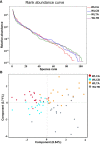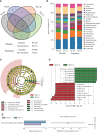Clinical efficacy of weight loss herbal intervention therapy and lifestyle modifications on obesity and its association with distinct gut microbiome: A randomized double-blind phase 2 study
- PMID: 37033234
- PMCID: PMC10073537
- DOI: 10.3389/fendo.2023.1054674
Clinical efficacy of weight loss herbal intervention therapy and lifestyle modifications on obesity and its association with distinct gut microbiome: A randomized double-blind phase 2 study
Abstract
Goals: To assess the efficacy and safety of Chinese Medicine Prescription "W-LHIT" in subjects with simple obesity, and to explore its potential mechanism of action.
Methods: Thirty-seven patients aged 18 to 60 from Wei-En hospital (Weifang City, Shandong, China), participated in a double blinded, placebo-controlled study. Subjects were randomly divided into 2 groups, 18 in treatment and 19 in placebo group. The treatment group took the "W-LHIT" capsules for two months, while the control group received placebo capsules. Both groups accepted healthy lifestyle education materials. After a 2-month treatment, the placebo group transferred to open-label treatment after unblinding.
Results: 72.22% participants in the treatment group lost more than 5% of their body weight, compared with 36.84% in the placebo group (p < 0.001). Body weight loss and body mass index reduction of the treatment group were also significantly higher than those of the placebo group (p < 0.05). These changes were accompanied by increased abundance of Akkermansia muciniphila and Enterococcus faecium, and decreased abundance of Proteobacteria in gut microbiota. Furthermore, the treatment group also showed improvement in obesity-related comorbidities such as hypertension and elevation of liver enzymes. No serious adverse reactions were found during the study period. Weight did not rebound at a follow-up visit 2 months after treatment.
Conclusion: W-LHIT significantly improved body weight and comorbid conditions without obvious adverse reaction or rebound weight gain. These effects were associated with increased abundance of probiotics in gut microbiota. W-LHIT may have a potential for treating obesity in conjunction with healthy lifestyle modifications.
Keywords: Akkermansia muciniphila; gut microbiome; lifestyle modifications; obesity; weight loss; “W-LHIT” capsule.
Copyright © 2023 Cao, Wei, Wen, Song, Srivastava, Yang, Shi, Miao, Chung and Li.
Conflict of interest statement
This study shared the US Patent No: US20160296573A1 Weight loss formulations, methods, and compositions based on Traditional Chinese Medicine by X-ML, DC, etc. Author DC was employed by Healthy Freedom LLC. Authors NY and K.S are members of General Nutraceutical Technology LLC. The remaining authors declare that the research was conducted in the absence of any commercial or financial relationships that could be construed as a potential conflict of interest.
Figures







Similar articles
-
Weight loss herbal intervention therapy (W-LHIT) a non-appetite suppressing natural product controls weight and lowers cholesterol and glucose levels in a murine model.BMC Complement Altern Med. 2014 Jul 23;14:261. doi: 10.1186/1472-6882-14-261. BMC Complement Altern Med. 2014. PMID: 25055851 Free PMC article.
-
Sibutramine is effective for weight loss and diabetic control in obesity with type 2 diabetes: a randomised, double-blind, placebo-controlled study.Diabetes Obes Metab. 2000 Apr;2(2):105-12. doi: 10.1046/j.1463-1326.2000.00071.x. Diabetes Obes Metab. 2000. PMID: 11220522 Clinical Trial.
-
The effects of co-administration of probiotics with herbal medicine on obesity, metabolic endotoxemia and dysbiosis: a randomized double-blind controlled clinical trial.Clin Nutr. 2014 Dec;33(6):973-81. doi: 10.1016/j.clnu.2013.12.006. Epub 2013 Dec 31. Clin Nutr. 2014. PMID: 24411490 Clinical Trial.
-
Targeting obesity management through gut microbiota modulation by herbal products: A systematic review.Complement Ther Med. 2019 Feb;42:184-204. doi: 10.1016/j.ctim.2018.11.019. Epub 2018 Nov 22. Complement Ther Med. 2019. PMID: 30670241
-
Gut Microbiota Dysbiosis in Human Obesity: Impact of Bariatric Surgery.Curr Obes Rep. 2019 Sep;8(3):229-242. doi: 10.1007/s13679-019-00351-3. Curr Obes Rep. 2019. PMID: 31197613 Review.
Cited by
-
Advances in Gut Microbiota-Targeted Therapeutics for Metabolic Syndrome.Microorganisms. 2024 Apr 24;12(5):851. doi: 10.3390/microorganisms12050851. Microorganisms. 2024. PMID: 38792681 Free PMC article. Review.
-
The Beneficial Effects of Dietary Interventions on Gut Microbiota-An Up-to-Date Critical Review and Future Perspectives.Nutrients. 2023 Dec 3;15(23):5005. doi: 10.3390/nu15235005. Nutrients. 2023. PMID: 38068863 Free PMC article. Review.
-
Changes in the Gut Microbiota after the Use of Herbal Medicines in Overweight and Obese Individuals: A Systematic Review.Nutrients. 2023 May 5;15(9):2203. doi: 10.3390/nu15092203. Nutrients. 2023. PMID: 37432344 Free PMC article.
-
Akkermansia muciniphila: A promising probiotic against inflammation and metabolic disorders.Virulence. 2024 Dec;15(1):2375555. doi: 10.1080/21505594.2024.2375555. Epub 2024 Aug 27. Virulence. 2024. PMID: 39192579 Free PMC article. Review.
-
Akkermansia muciniphila - impact on the cardiovascular risk, the intestine inflammation and obesity.Acta Biochim Pol. 2024 Nov 14;71:13550. doi: 10.3389/abp.2024.13550. eCollection 2024. Acta Biochim Pol. 2024. PMID: 39611203 Free PMC article. Review.
References
-
- Ng MT, Fleming M, Robinson B, Thomson N, Graetz C, Margono E, et al. . Global, regional, and national prevalence of overweight and obesity in children and adults during 1980–2013: A systematic analysis for the global burden of disease study 2013. Lancet (2014) 384(9945):766–81. doi: 10.1016/S0140-6736(14)60460-8 - DOI - PMC - PubMed
Publication types
MeSH terms
LinkOut - more resources
Full Text Sources
Research Materials

